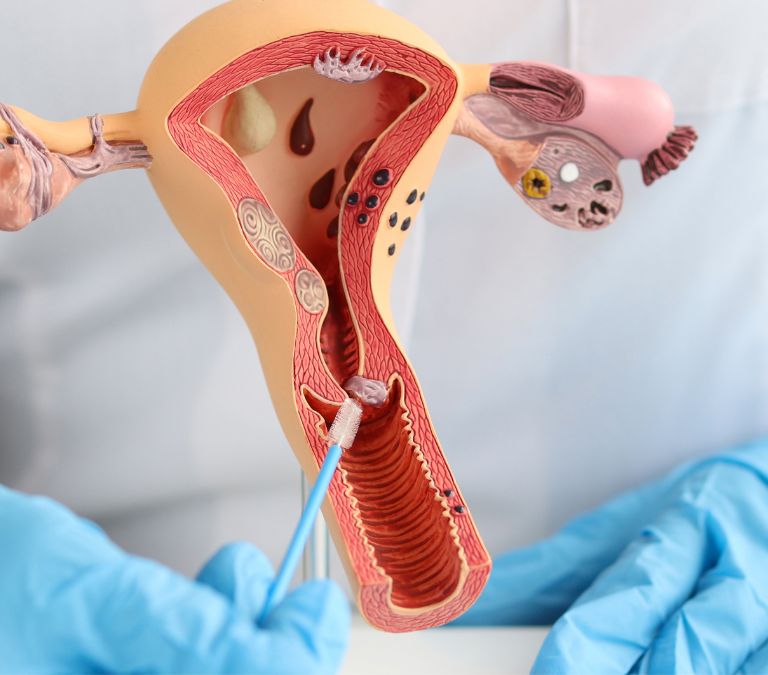I woke up one morning after sleeping and found my gown stained. Now, normally I wouldn’t be worried. It is normal for a woman to bleed, and stains are usually commonplace after sleeping. But the problem was, I was already in my fifties and way into menopause, so this was not usual. So naturally, I was a bit scared. But then I talked to a few friends and found out that it wasn’t that rare a situation.
We know the drill about menopause. Our bodies go through this phase at a certain time in our lives. Hormonal changes, predominantly changes in estrogen levels, will cause further physiological changes. One change is that we stop seeing our periods! And for some, this is something to be happy about! It means no more tampons!
So, it will be a surprise if you start bleeding after menopause. Isn’t menopause supposed to me that we would no longer bleed? Isn’t menopause a cessation of our menstrual cycles? So why do we bleed after menopause? The answer is quite clear. It has to be due to some other reasons.
Can Periods Restart after Menopause?

The first thing I thought of when I saw the spot was, could it be possible that my period had come back? After staying for 12 months without seeing a single period, I confirmed my postmenopausal status with a doctor. So the question I asked myself was, could it be possible that my period restarted?
And that was the first question I asked my healthcare provider. She replied that my periods couldn’t come back after menopause. Therefore, spotting after menopause is not normal. As long as you have received a definitive diagnosis about your menopausal state, you should be worried if you notice bleeding from your vagina after menopause.
If you notice you are spotting after menopause, please do not put it off, no matter how slight or heavy. Instead, contact your healthcare provider and get yourself checked out. You will find out that what you have isn’t life-threatening in the best-case scenario. In the worst-case scenario, you could be facing a potentially difficult condition. Early detection might be your saving grace.
We have established that there is no way that your period will restart after you have been confirmed postmenopausal. However, if you are still bleeding from your vagina, there is probably another reason it happens. Let’s look at some of these reasons and see why they lead to spotting after menopause. We will also tell you what to do about them.
What Does Light Brown Discharge after Menopause Mean?
When you bleed after menopause, it could be a heavy flow, or it could just be a light discharge. The most common form of this is the light brown discharge; if you have this, you are about to find out why.
Let us point out that a light brown spotting after menopause should not get you so worked up. It is especially true if it is not constant. However, there could be a chance that the bleeding might result from another health issue. It is advisable to visit your healthcare provider in situations like this.
The most common cause of light brown discharge could be due to another very common symptom of menopause, and that is vaginal atrophy. During menopause and even afterward, during postmenopause, our vaginal walls tend to become dryer and thinner. It will often lead to infections which usually cause a discharge. In addition, when blood mixes in with this discharge, the discharge color will probably turn a light brown.
Causes of Spotting after Menopause

Let’s get to the gist of the discussion. Talking about this is well and all. But we also need to figure out what exactly causes this condition and discuss how best to handle it. Like my friend would say, “After menopause, we do not have any more business with vaginal bleeding. And if it happens, then it is never a good sign!” And that is the truth. If you have gotten a successful postmenopausal diagnosis, you should not be bleeding. If you are, there is something wrong, and I am here to tell you some reasons behind spotting after menopause.
- A Misdiagnosis of Menopause
Perimenopause is the phase that comes before menopause. In most cases, it is characterized by irregular menstruation, and it is not rare to see you go for months without seeing your period. But in this phase, it is still possible to get a period. As a result, many people do not bother going for a proper diagnosis. Instead, they diagnose themselves by themselves, and eventually, they are shocked when they realize they are still bleeding.
It will help if you get a proper diagnosis. Do not assume that you are postmenopausal if you are not. It will save you a lot of worry, stress, money, and time.
- Endometrial and Vaginal Atrophy
It is the most common cause of spotting after menopause. It should not come as a surprise. There are a lot of menopausal women who have this symptom. By implication, they might bleed even though they are postmenopausal.
We all know that during menopause, our vaginal walls tend to dry because of the decrease in estrogen level. Unfortunately, this decrease in estrogen also leads to thinning of these walls. This condition can lead to bleeding from the vaginal even though you have gone through menopause. It can also lead to infection and discharge of fluid, which results in the light brown spotting that you might sometimes notice when it mixes with the blood.
The endometrium is another tissue that responds to decreased estrogen and progesterone in menopause. It is the thin layer of tissue that lines your uterus. Unfortunately, during menopause, it also gets thin and dry, which can lead to bleeding even after menopause is confirmed.
Uterine Polyps
Polyps present as tissue growths. Have you ever removed the mushroom cap and left just the stalk? That is what a polyp looks like. They are usually very small and are not considered cancerous in most cases. The most common kinds of polyps are intestinal polyps and uterine polyps.
Uterine polyps are not cancerous, but a tiny percentage of them have the potential to become cancerous. However, the most common symptom of this condition is irregular bleeding. Women who present with this condition tend to bleed from time to time.
Also, this condition is very common among women like us who have gone through menopause. It means that this condition causes your bleeding to be very high. When a menopausal woman has polyps, the level of bleeding might differ from woman to woman or from each episode to each.
It could be a slight spotting, bleeding after sexual intercourse, or heavy bleeding like the type seen during the usual menstrual cycle.
- Endometrial Hyperplasia
I have mentioned before that thinning of your endometrium can lead to bleeding. Well, the opposite is also true. You see, endometrial hyperplasia is the opposite of endometrial atrophy. So this means that the lining of your uterus starts thickening in this situation. And it is seen in women who are menopausal more than in women of other ages.
Endometrial hyperplasia is usually due to a high estrogen level without sufficient progesterone. Women who use estrogen-only hormone replacement therapy suffer from this condition.
This thickening of the endometrium can also lead to spotting after menopause. But it doesn’t end there. You see, hyperplasia is synonymous with proliferation! And do you know what else is synonymous with that? Yeah, Cancer! This thickening of the endometrium can lead to cancer. If you notice bleeding, you should visit your healthcare provider, get the proper diagnosis and start treatment as soon as possible. You do not want to deal with this condition’s repercussions!
- Endometrial Cancer
Let’s talk a bit about cancer now. I mentioned that endometrial hyperplasia might lead to cancer, right? It is one of the types of cancers it can lead to.
Since the endometrium is a part of the uterus, endometrial cancer should start in the uterus. But it is also very quick to increase. So it is usually something menopausal women have to deal with more. The symptoms accompanying this condition are pelvic pains and irregular and abnormal bleeding.
Why this condition is dangerous, the signs make them easily detectable. Who would not worry if they had to deal with pelvic pain and bleeding from the vagina, especially when they are no longer supposed to be having their periods? So many of the cases of postmenopausal bleeding seen in women are due to this condition.
The treatment of choice is usually the removal of the uterus. However, this might not be necessary depending on how early the cancer is detected.
- Cervical Cancer
This type of cancer is sometimes due to the endometrial hyperplasia I mentioned before. However, there are other causes of this condition. For example, when you bleed after menopause, it could be that you have cervical cancer. It is a rare symptom, but it is still possible.
Cervical cancer is a lot more dangerous than endometrial cancer. This condition progresses slowly, so symptoms might not be visible until too late. We need regular health check-ups even after menopause. If I am to say, it is even more necessary once we become menopausal because menopause puts us at risk of many health issues.
If you are spotting after menopause, look for other symptoms like pain during intercourse or abnormal discharge from the vagina. These are all important when your doctor is trying to pinpoint if your bleeding results from cervical cancer.
- Sexually Transmitted Infections
It could also be bleeding because you have contracted a sexually transmitted infection. Infections like chlamydia and gonorrhea are known to cause abnormal spotting. So if you are noticing signs of these very common STIs, then there is every chance that your vaginal bleeding is from them.
Herpes is also capable of causing bleeding. Though it is usually very minor, sores from herpes can bleed and lead to spots.
Ensure you contact your healthcare provider and get treatment for your sexually transmitted infections.
- Hormone Replacement Therapy
Somewhere in this article, I already mentioned that an increased estrogen level leads to a condition known as hyperplasia. As postmenopausal women, we are supposed to be seeing a decrease in our estrogen levels, but sometimes this is not the case.
A good example is when we use estrogen-only hormone replacement therapy. When we do this, the walls of our uterus will respond by thickening, which could lead to abnormal bleeding even though we are no longer seeing our periods.
It could also be due to other medications for menopause or otherwise. For example, another medication that has been implicated in this scenario is our blood thinners.
Diagnosis
Let’s talk a bit about how this condition is diagnosed. As we have mentioned earlier, there are a lot of underlying conditions that could result in you spotting after menopause. Therefore, you must get a proper diagnosis when you notice bleeding from your vagina.
When you get to your healthcare provider, the first thing they would do is to take a thorough medical history. I want to mention here that you need to be honest and forthcoming. I know this has to deal with our vagina, so we might not want to discuss it much, but you have to. It is the only way your doctor can start narrowing down what is wrong with you.
Then the doctor will most likely perform a physical examination and a pap smear. This examination is to check if the bleeding is due to cervical cancer. When the doctor is done, they might request other tests to make a sure diagnosis. Some of these tests include:
- Transvaginal Ultrasound
With this procedure, your doctor will get a clear image of your reproductive organs, including the cervix and the uterus. In addition, it will help the healthcare practitioner check for growth and how thick your uterine lining is.
A probe capable of sending out sound waves is inserted into your vagina, and these sound waves allow the creation of images that accurately describe the inside of your body. It is a bit invasive, so your health care provider should help you get comfortable as much as possible, and if you are not, you can insert the probe yourself.
- Endometrial Biopsy
In this case, a tissue sample is collected from your uterine wall. This sample is now sent to the lab for proper tests. It is usually done when cancer or infection is suspected.
- Hysteroscopy
Your doctor might decide that they want to see the inside of your uterus. If this is the case, then they might use a hysteroscope. It is a thin tube of light with a camera at the end. It is used to get a clear picture of the uterus after carbon dioxide is blown into it.
- Dilation and Curettage
Dilation and curettage is a two-way procedure. The first process is dilation; during this process, the doctor dilates your cervix. Then, using a curette, a long instrument shaped like a thin spoon, they will scrape tissue samples from the uterine lining. This sample is sent to a lab for proper analysis.
It is a very invasive procedure and even requires anesthesia. In addition, most doctors might not prescribe it if they do not think it is necessary—the procedure checks for the causes of vaginal bleeding.
Treatment
And this is the most important part of this piece! How do you get rid of the bleeding? How do you make it stop?
Remember that we already mentioned the conditions that could lead to bleeding from the vagina? To treat the bleeding, you have to treat the underlying cause. So let’s consider some things you can do to handle this condition.
Medication for Spotting after Menopause

- Estrogen
Estrogen is usually the treatment choice if the cause of the bleeding is vaginal or endometrial atrophy. These conditions are hugely motivated by the lack of estrogen seen during menopause. Depending on the severity of the symptoms, your doctor will prescribe any estrogen therapy forms.
The most common these two conditions are:
- The topical vaginal cream.
- The vaginal ring lasts about three months.
- The tablet works for a couple of days.
They might also prescribe the pill, but this is not usually the case, especially as they try to reduce systemic estrogen therapy’s side effects when it is unnecessary.
- Progestin
I told you earlier that your bleeding could be due to endometrial hyperplasia. Now, most times, this condition is due to an excess of estrogen without matching progesterone levels.
Progestin is a synthesized form of progesterone. And it is used for treating this thickening of the uterus wall. Like estrogen therapy, this form of therapy comes as pills or creams. But you can also take them as shorts.
- Antibiotics
If your spotting is due to a sexually transmitted infection, this might be the medication of choice. Or any form of infection that affects the reproductive system.
To know which antibiotics work best, the doctor might request that a sensitivity test be carried out on you.
Surgery For Spotting After Menopause
There are surgical procedures that will help with the spotting after menopause. However, like the medications mentioned earlier, for this surgery to be effective, you need to get a proper diagnosis of the underlying cause of your bleeding.
- Hysteroscopy
I had already mentioned this before while I mentioned further tests to run when diagnosing the cause of your bleeding. Well, with this procedure, you can also surgically remove polyps. It is also a very good way of removing the parts of the uterine wall resulting from hyperplasia. To do this, they insert the hysteroscope through the vagina and, using it as a guide, pass tiny surgical tools and use them to remove these tissues.
- Dilation and Curettage
Dilation and curettage is another test procedure that also counts as surgical treatment. This procedure starts with dilation, which refers to opening up the cervix. It is followed by curettage, where the surgeon uses a tool that looks like a thin spoon to scrape out polyps or the areas of your uterus that have been thickened by endometrial hyperplasia.
- Hysterectomy
Hysterectomy is usually the last option for most people and is a cancer treatment. However, your doctor might also prescribe it if they notice that the proliferation of your hyperplasia is becoming malignant. Hysterectomy is the surgical removal of the uterus. Depending on the condition and how far it has spread, your doctor might decide to remove part of your uterus, all of your uterus, or all of your uterus and some surrounding organs, like your fallopian tubes and your ovaries.
After surgery, depending on how far gone the spread is, you might be required to take further treatment, like chemo or radiation. Again, this usually depends on the kind of cancer and how far along you were before it was discovered.
Spotting after menopause is a cause for worry. Bleeding should not be the case, especially years after you have seen your last period. I was extremely worried when I noticed I was bleeding. Still, I didn’t have to worry much about a visit to my healthcare provider and proper treatment. If you notice that you are spotting after menopause, visit your healthcare provider to get a proper diagnosis and treatment.







